The current placement of wind turbines in the central and southern Great Plains may have relatively few negative effects on sandhill cranes wintering in the region, according to a new study from the U.S. Department of the Interior’s (DOI) U.S. Geological Survey (USGS).
The study says midcontinental sandhill cranes are important to sporting and tourism industries in the Great Plains, an area where wind energy development recently surged.
The USGS scientists say potential threats of wind turbines to cranes include collisions and avoidance of areas near towers – which reduces available roosting and foraging habitat.
Scientists compared crane location data from the winters of 1998-2007 with current wind sites in Texas, Oklahoma, Kansas and New Mexico prairies. Findings showed only a 7% overlap between cranes and wind turbines and that most turbines have been placed in areas not often used by cranes during the winter.
“Great Plains wetlands are critical to preserving valuable sandhill crane populations,” says USGS scientist Aaron Pearse, the study’s lead author. “Our findings can help managers minimize risks of future wind energy development to cranes by highlighting potentially hazardous locations.”
Using data from cranes tagged with satellite transmitters, the scientists estimated wintering crane distributions and habitat selection behaviors prior to and during wind tower construction, which began in 1999 but surged from 2004-2013, according to the study. They then compared the early estimates with post-construction bird behaviors and current tower locations.
“Although about 50 percent of cranes in our study used locations that had wind towers nearby – within 10 kilometers, or about 6.2 miles – there were few instances in which high densities of cranes and high densities of towers coincided,” Pearse adds.
The study further showed the following:
- A modest 7% overlap between study areas visited by cranes during the winters of 1998-2004 and areas with wind towers constructed during 1999-2013;
- When they spent time near wind towers, the wintering cranes maintained an average distance of 6.5 kilometers, or about 4 miles, from the towers;
- Only 5% of wind turbines in the Texas High Plains have been constructed in locations identified as highly preferred crane winter habitat; and
- Wintering cranes generally selected wetlands or upland areas near wetland basins.
The full study can be found here.
Photo courtesy of the USGS




